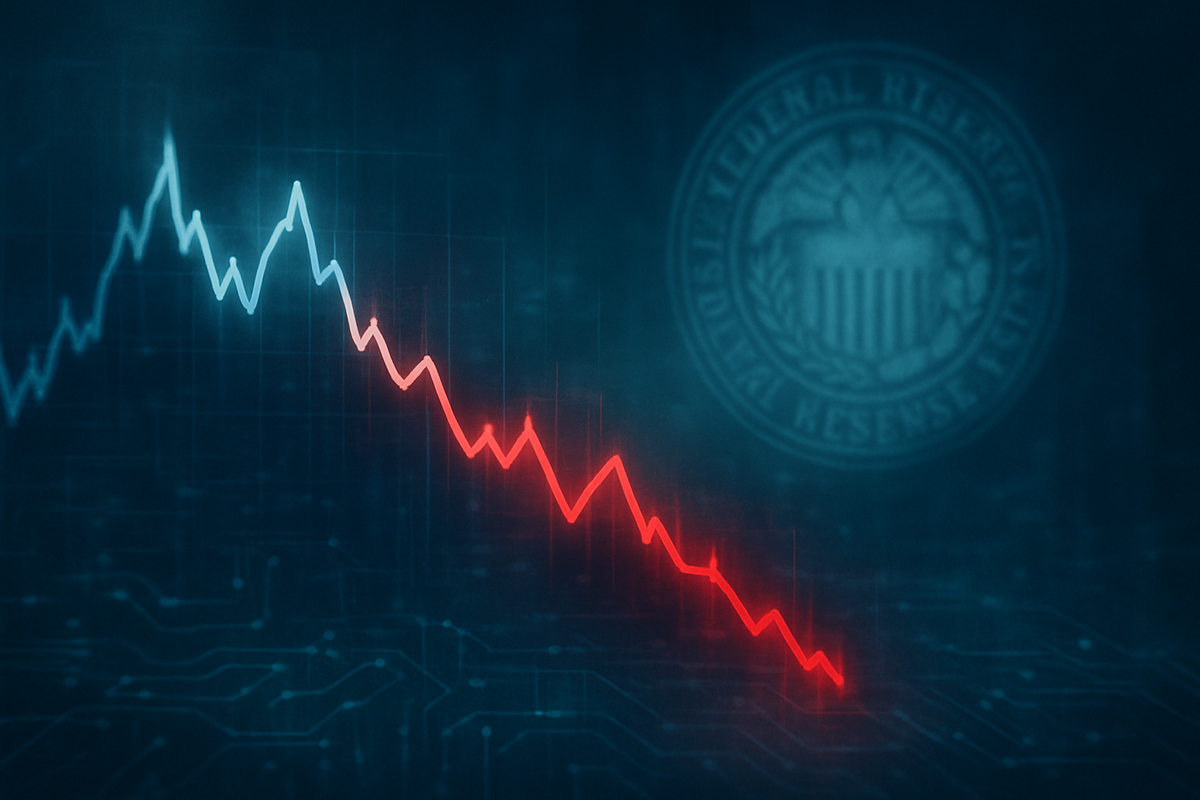
November 21, 2025 - The specter of Federal Reserve uncertainty continues to cast a long shadow over financial markets, manifesting in heightened volatility and swift reversals, even for market darlings like Nvidia. Despite reporting stellar third-quarter earnings, the AI chip giant experienced a sharp stock reversal this week, serving as a potent reminder of how deeply intertwined market sentiment is with the anticipated trajectory of monetary policy. This event underscores a critical dynamic: market participants are meticulously scrutinizing every utterance from the Fed and every piece of economic data, attempting to divine the future of interest rates, a pursuit that often leads to dramatic shifts in asset valuations.
The recent whipsaw in Nvidia's stock exemplifies the immediate implications of this uncertainty, particularly for high-growth companies. While robust corporate performance can offer temporary buoyancy, the overarching concern regarding the cost of capital and future economic conditions, heavily influenced by the Fed's stance, can quickly overshadow individual company strengths. As investors grapple with mixed economic signals and divided opinions within the central bank, the market remains on edge, prone to rapid adjustments based on shifting expectations for monetary tightening or easing.
The Nvidia Rollercoaster: A Microcosm of Macro Uncertainty
The dramatic events surrounding Nvidia's (NASDAQ: NVDA) stock this week provide a vivid illustration of how deeply Federal Reserve uncertainty can impact even the strongest performers. On Wednesday, November 20, 2025, Nvidia announced impressive third-quarter fiscal year 2026 revenues of $57 billion, comfortably surpassing market expectations, and offered an equally optimistic revenue forecast for Q4 FY2026. This news initially ignited a significant rally, with Nvidia shares soaring over 5% in after-hours trading and contributing to a positive open for the broader market on Thursday.
However, this initial euphoria proved fleeting. By Thursday afternoon, the rally had not only evaporated but transformed into a notable rout. Nvidia's stock ultimately closed down 3.2% from its Wednesday close and a staggering 7.8% from its Thursday opening price. This swift reversal was not a reflection of any new negative news from Nvidia itself, but rather a direct consequence of a sudden shift in investor perception regarding the Federal Reserve's likely actions on interest rates.
The primary catalysts for this abrupt change in sentiment were twofold. Firstly, the release of delayed September jobs reports on Thursday morning presented a mixed picture of the U.S. labor market. While the economy added more jobs than anticipated, the unemployment rate also ticked upwards, creating conflicting signals for the Fed's dual mandate of maximum employment and price stability. Secondly, hawkish commentary from several Fed officials, coupled with the minutes from the October FOMC meeting revealing significant divisions among policymakers regarding a potential December rate cut, dramatically dampened expectations for near-term monetary easing. Key players in this scenario include the Federal Reserve, whose communications and policy decisions are paramount; market analysts and economists, who interpret these signals; and investors, who react to these interpretations, influencing stock movements. This collective "Fed watching" behaviour often leads to exaggerated market reactions to seemingly subtle shifts in the central bank's tone or economic data.
Companies Navigating the Fed's Shifting Sands
The prevailing Fed uncertainty creates a distinct landscape of winners and losers across the market, with growth-oriented companies often bearing the brunt of the volatility. Companies like Nvidia (NASDAQ: NVDA), which are valued heavily on their future earnings potential, are particularly vulnerable to shifts in interest rate expectations. When the prospect of "higher for longer" interest rates looms, the discount rate applied to these future earnings increases, diminishing their present value and making their stocks less attractive. Furthermore, many growth companies rely on debt to finance their rapid expansion and innovation, making them sensitive to rising borrowing costs.
Conversely, sectors and companies that are less sensitive to interest rates or that benefit from a slower, more stable economic environment might fare better. Value stocks, often characterized by more stable current earnings and lower growth expectations, tend to be less impacted by changes in the discount rate. Financial institutions (NYSE: XLF), for instance, can sometimes benefit from higher interest rates, as it allows them to earn more on their lending activities, though a sharp economic slowdown could counteract this. Consumer staples (NYSE: XLP) and utilities (NYSE: XLU), which provide essential goods and services, often demonstrate greater resilience during periods of economic uncertainty, as demand for their products remains relatively stable regardless of interest rate fluctuations.
However, even for these "safer" investments, extreme volatility driven by Fed uncertainty can still create headwinds. The broader market's risk-off sentiment can lead to indiscriminate selling, impacting even fundamentally sound companies. The key for companies in this environment is adaptability: those with strong balance sheets, efficient operations, and diverse revenue streams are better positioned to weather the storm. Companies heavily reliant on external financing for growth or those with significant short-term debt exposure face increased pressure as borrowing costs remain elevated or become unpredictable.
Wider Implications: Beyond Individual Stock Swings
The recent Nvidia stock reversal, driven by Federal Reserve uncertainty, is more than just an isolated event; it's a stark indicator of broader industry trends and potential ripple effects across the financial landscape. This episode highlights the continued sensitivity of the technology sector, particularly high-growth areas like artificial intelligence and semiconductors, to monetary policy. The "higher for longer" interest rate narrative, or even just the delay of anticipated rate cuts, disproportionately impacts tech companies whose valuations are often predicated on long-term growth and whose business models frequently involve significant capital expenditure and reliance on future profitability.
The ripple effects extend to competitors and partners within the semiconductor ecosystem. Companies like Advanced Micro Devices (NASDAQ: AMD) and Intel (NASDAQ: INTC), while having different market focuses, are also subject to the same macro-economic pressures. A slowdown in tech spending or increased cost of capital due to Fed policy could temper demand for their products and services. Moreover, the broader supply chain for semiconductors, from equipment manufacturers to material suppliers, could experience demand fluctuations. Partners relying on Nvidia's technology for their own AI solutions might face increased cost pressures or slower market adoption if the economic environment becomes less favorable for investment.
From a regulatory and policy perspective, persistent Fed uncertainty underscores the delicate balancing act central banks face in managing inflation while supporting economic growth. The conflicting signals from economic data and the divided opinions within the FOMC reflect the complexity of the current economic environment. This situation could lead to increased scrutiny of the Fed's communication strategies and calls for greater clarity in their forward guidance to mitigate market volatility. Historically, periods of significant monetary policy shifts, such as the Volcker era in the early 1980s or the post-2008 quantitative easing and tightening cycles, have been characterized by similar market sensitivity and re-evaluations of asset classes. The current scenario echoes these precedents, where the market's perception of the central bank's resolve and strategy becomes a dominant force.
What Comes Next: Navigating a Volatile Future
Looking ahead, the immediate future for financial markets will likely remain tethered to the Federal Reserve's actions and communications. In the short term, investors will continue to dissect every piece of economic data, particularly inflation reports and labor market statistics, for clues regarding the Fed's next move. Any deviation from anticipated data or any unexpected commentary from Fed officials could trigger further market volatility, similar to the Nvidia reversal. Short-term possibilities include continued choppiness, with sectors sensitive to interest rates experiencing greater swings. Companies may need to adapt by focusing on cost control, optimizing capital allocation, and strengthening their balance sheets to withstand potential economic headwinds.
In the long term, the trajectory of monetary policy will significantly influence investment strategies. If the Fed ultimately signals a sustained "higher for longer" approach, it could necessitate a broader re-evaluation of growth stock valuations and a potential shift towards more value-oriented investments. Conversely, if economic data warrants a pivot towards rate cuts, it could reignite enthusiasm for growth sectors. Potential strategic pivots for companies might include diversifying revenue streams, focusing on operational efficiency over aggressive expansion, and exploring alternative financing methods that are less sensitive to interest rate fluctuations. Market opportunities may emerge in defensive sectors or in companies that demonstrate robust free cash flow generation and resilience in a higher-rate environment.
Potential scenarios and outcomes for monetary policy range from a continued pause with a hawkish bias, leading to prolonged uncertainty, to an eventual easing cycle driven by weakening economic data. The most challenging scenario for markets would be a prolonged period of high inflation coupled with slowing growth, forcing the Fed into difficult choices. Investors should prepare for continued uncertainty, emphasizing diversification and a long-term perspective. The ability to adapt to changing monetary policy expectations will be paramount for both companies and investors in the coming months.
Wrap-Up: A Market Defined by Fed Signals
The recent episode with Nvidia's stock reversal serves as a potent summary of the current financial market landscape: one heavily influenced, if not dominated, by Federal Reserve uncertainty. The market's hypersensitivity to Fed signals and economic data has become a defining characteristic, leading to swift and often dramatic shifts in asset valuations. The key takeaway is that even exceptional corporate performance can be overshadowed by macro-economic anxieties, particularly concerning the future path of interest rates.
Moving forward, the market will continue to assess the Fed's commitment to its inflation targets versus its mandate for maximum employment. This ongoing assessment will dictate the broader investment climate, influencing capital flows and sector performance. Investors should recognize that periods of high Fed uncertainty inherently come with elevated volatility. A balanced approach, focusing on fundamentally strong companies with clear growth drivers and robust financial health, regardless of short-term market noise, remains crucial.
In the coming months, investors should closely watch for clarity from the Federal Reserve regarding its long-term monetary policy stance. Key indicators to monitor include inflation data (CPI, PPI), employment reports (non-farm payrolls, unemployment rate, wage growth), and any public statements or speeches from Fed officials. Any signs of a consistent policy direction, whether hawkish or dovish, could help reduce uncertainty and potentially stabilize markets. However, until such clarity emerges, expect the market to remain a reactive arena, where the shadow of the Fed continues to loom large over every trade.
This content is intended for informational purposes only and is not financial advice







